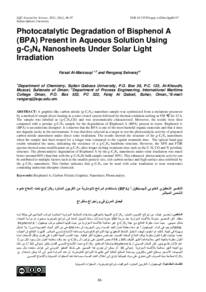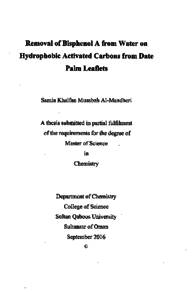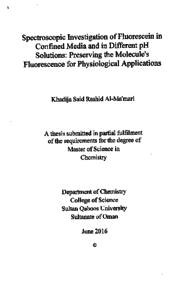Document
Probing the interaction between bisphenol A (BPA) with whey and casein proteins.
Source
Master's thesis
Other titles
التحقق من التفاعل بين البيسفينول أ (BPA) مع بروتينات مصل اللبن والكازين.
Country
Oman
City
Muscat
Publisher
Sultan Qaboos University.
Gregorian
2024
Language
English
Thesis Type
Master's thesis
English abstract
2,2-bis(4-hydroxyphenyl) propane, often known as bisphenol A (BPA), is an organic substance that is made by combining acetone and phenol and is used to make epoxy resins and polycarbonate plastics. Epoxy resins are used to coat metal can surfaces that are in contact with foods and beverages. BPA is considered as an endocrine disruptor which can exhibits estrogenic activity [1]. BPA can migrate from cans and polycarbonate plastics to foods. In a recent study, it was shown that 0.5 mg/kg of BPA may migrate from food packaging to its contents [2]. Studies have shown that BPA can cause adverse health effects such as an increase in insulin resistance, obesity, diabetes, and infertility in men. Furthermore, studies on BPA exposure verify that, of all sources and across all population groups, diet is the most important exposure source. Milk products are considered one of the widely consumed products by infants, children, and adults. Milk contains two main kinds of proteins. Casein makes up 80% of the proteins found in milk, whereas whey makes up 20%. Recent scientific attention has been focused on BPA's interactions with certain proteins to better understand the toxicity mechanism. Therefore, in this study, our intention is to provide investigation on the interaction of BPA with the two milk proteins by molecular modeling and electronic spectroscopy such as UV-visible absorption spectroscopy (UVA) and fluorescence spectroscopy (FL). In order to determine the optimum conditions to conduct the interaction experiments, the pH and concentration dependence on the FL emission and UVA spectra of these molecules are studied first. By estimating the binding constant, the level of toxicity of BPA is determined. Further the type of molecular interaction between the molecules is evaluated through analyzing the Stern-Volmer plots. In order to gain deeper insight on the complexation process of BPA with the proteins, we have conducted molecular dynamics (MD) simulations on these systems. Our results indicate that the BPA molecules prefer to bind to the proteins within the pockets dominantly made by tryptophan (TRP) residues, which is in agreement with our spectroscopy measurements. We further analyze the factors contributing to stability of the complex between BPA and proteins which are root mean square deviation (RMSD), root means square fluctuation (RMSF), radius of gyration (𝑅𝑔), solvent accessible surface area (SASA), and
Ramachandran plot. The results showed that the conformational changes introduced by the addition of BPA in casein protein are higher than that for whey protein. Our results are key to the designing of package materials and conditions to store the milk in liquid form. Fӧrster energy transfer analyses were done. The intermolecular distance between the donor and the acceptor was calculated to be 1.3 nm which is near to 0.8 nm of TYR calculated by MD simulation.
Arabic abstract
2,2 مكرر (4-هيدروكسي فينيل) البروبان، المعروف غالبًا باسم بيسفينول أ (BPA)، هو مادة عضوية يتم تصنيعها عن طريق الجمع بين الأسيتون والفينول، وتُستخدم في صناعة منتجات الإيبوكسي والبلاستيك. تُستخدم منتجات الإيبوكسي لتغطية أسطح العلب المعدنية التي تتلامس مع الأطعمة والمشروبات. يُعتبر BPA مادة مُخلّة بالغدد الصماء ويمكن أن تظهر نشاطًا إستروجينيًا [1]. يمكن أن تنتقل مادة BPA من العلب والمواد البلاستيكية المصنوعة من البولي كربونات إلى الأطعمة. في دراسة حديثة، تبين أن 0.5 ملغم/كغم من مادة BPA قد تنتقل من عبوات المواد الغذائية إلى محتوياتها [2].
أظهرت الدراسات أن مادة BPA يمكن أن تسبب آثارًا صحية ضارة مثل زيادة مقاومة الأنسولين، والسمنة، والسكري، والعقم لدى الرجال. علاوة على ذلك، تؤكد الدراسات التي أُجريت على التعرض لـBPA أنه من بين جميع المصادر وفي جميع الفئات العمرية، يُعد النظام الغذائي هو المصدر الأكثر أهمية للتعرض. تُعتبر منتجات الألبان من المنتجات التي يستهلكها الرضع والأطفال والبالغون على نطاق واسع. يحتوي الحليب على نوعين رئيسيين من البروتينات: يشكل الكازين 80% من البروتينات الموجودة في الحليب، في حين يشكل مصل اللبن 20%.
لقد تركز الاهتمام العلمي مؤخرًا على تفاعلات BPA مع بروتينات معينة لفهم آلية السمية بشكل أفضل. لذلك، في هذه الدراسة، هدفنا هو تقديم بحث حول تفاعل BPA مع بروتيني الحليب عن طريق النمذجة الجزيئية والتحليل الطيفي الإلكتروني مثل التحليل الطيفي للامتصاص المرئي فوق البنفسجي (UVA) والتحليل الطيفي الفلوري (FL). لتحديد الظروف المثلى لإجراء تجارب التفاعل، تم دراسة اعتماد الرقم الهيدروجيني والتركيز على انبعاث FL وأطياف UVA لهذه الجزيئات أولًا. ومن خلال تقدير ثابت الارتباط، تم تحديد مستوى سمية مادة BPA.
علاوة على ذلك، تم تقييم نوع التفاعل الجزيئي بين الجزيئات من خلال تحليل مخططات ستيرن-فولمر. للحصول على رؤية أعمق حول عملية تعقيد BPA مع البروتينات، أجرينا محاكاة للديناميكيات الجزيئية (MD) على هذه الأنظمة. تشير نتائجنا إلى أن جزيئات BPA تفضل الارتباط بالبروتينات داخل الجيوب التي تحتوي بشكل رئيسي على التربتوفان (TRP)، وهو ما يتوافق مع قياسات التحليل الطيفي لدينا.
قمنا أيضًا بتحليل العوامل التي تساهم في استقرار المركب بين BPA والبروتينات مثل انحراف الجذر التربيعي المتوسط (RMSD)، وتقلب الجذر التربيعي المتوسط (RMSF)، ونصف قطر الدوران (Rg)، ومساحة السطح التي يمكن الوصول إليها بالمذيب (SASA)، ومخطط راماشاندران. أظهرت النتائج أن التغييرات التكوينية الناتجة عن إضافة BPA في بروتين الكازين كانت أعلى من تلك الخاصة ببروتين مصل اللبن.
تُعد نتائجنا أساسية لتصميم مواد التعبئة والتغليف والظروف اللازمة لتخزين الحليب في صورة سائلة. كذلك، تم إجراء تحليل نقل الطاقة فورستر، وتم حساب المسافة بين الجزيئات بين المتبرع والمستقبل لتكون 1.3 نانومتر، وهو ما يتطابق مع محاكاة MD التي بلغت 0.8 نانومتر.
أظهرت الدراسات أن مادة BPA يمكن أن تسبب آثارًا صحية ضارة مثل زيادة مقاومة الأنسولين، والسمنة، والسكري، والعقم لدى الرجال. علاوة على ذلك، تؤكد الدراسات التي أُجريت على التعرض لـBPA أنه من بين جميع المصادر وفي جميع الفئات العمرية، يُعد النظام الغذائي هو المصدر الأكثر أهمية للتعرض. تُعتبر منتجات الألبان من المنتجات التي يستهلكها الرضع والأطفال والبالغون على نطاق واسع. يحتوي الحليب على نوعين رئيسيين من البروتينات: يشكل الكازين 80% من البروتينات الموجودة في الحليب، في حين يشكل مصل اللبن 20%.
لقد تركز الاهتمام العلمي مؤخرًا على تفاعلات BPA مع بروتينات معينة لفهم آلية السمية بشكل أفضل. لذلك، في هذه الدراسة، هدفنا هو تقديم بحث حول تفاعل BPA مع بروتيني الحليب عن طريق النمذجة الجزيئية والتحليل الطيفي الإلكتروني مثل التحليل الطيفي للامتصاص المرئي فوق البنفسجي (UVA) والتحليل الطيفي الفلوري (FL). لتحديد الظروف المثلى لإجراء تجارب التفاعل، تم دراسة اعتماد الرقم الهيدروجيني والتركيز على انبعاث FL وأطياف UVA لهذه الجزيئات أولًا. ومن خلال تقدير ثابت الارتباط، تم تحديد مستوى سمية مادة BPA.
علاوة على ذلك، تم تقييم نوع التفاعل الجزيئي بين الجزيئات من خلال تحليل مخططات ستيرن-فولمر. للحصول على رؤية أعمق حول عملية تعقيد BPA مع البروتينات، أجرينا محاكاة للديناميكيات الجزيئية (MD) على هذه الأنظمة. تشير نتائجنا إلى أن جزيئات BPA تفضل الارتباط بالبروتينات داخل الجيوب التي تحتوي بشكل رئيسي على التربتوفان (TRP)، وهو ما يتوافق مع قياسات التحليل الطيفي لدينا.
قمنا أيضًا بتحليل العوامل التي تساهم في استقرار المركب بين BPA والبروتينات مثل انحراف الجذر التربيعي المتوسط (RMSD)، وتقلب الجذر التربيعي المتوسط (RMSF)، ونصف قطر الدوران (Rg)، ومساحة السطح التي يمكن الوصول إليها بالمذيب (SASA)، ومخطط راماشاندران. أظهرت النتائج أن التغييرات التكوينية الناتجة عن إضافة BPA في بروتين الكازين كانت أعلى من تلك الخاصة ببروتين مصل اللبن.
تُعد نتائجنا أساسية لتصميم مواد التعبئة والتغليف والظروف اللازمة لتخزين الحليب في صورة سائلة. كذلك، تم إجراء تحليل نقل الطاقة فورستر، وتم حساب المسافة بين الجزيئات بين المتبرع والمستقبل لتكون 1.3 نانومتر، وهو ما يتطابق مع محاكاة MD التي بلغت 0.8 نانومتر.
Category
Theses and Dissertations



